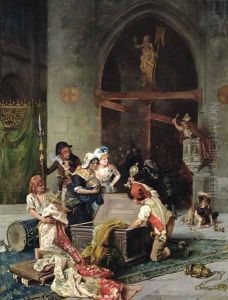Victor-Henri Juglar Paintings
Victor-Henri Juglar, primarily known as Henri Juglar or sometimes as Henri Victor Juglar, was a French artist who was active during the late 19th and early 20th centuries. Although not as widely recognized as some of his contemporaries, Juglar contributed to the art world through his works which encompassed a variety of themes and styles.
Henri Juglar was born in 1862 in France, during a period when the art world was undergoing significant changes. The aftermath of the 1848 revolutions across Europe had unsettled the old order, and by the time Juglar was coming of age, the Impressionist movement was beginning to take hold. This was a time when artists were increasingly challenging traditional techniques and subject matter, seeking to capture the immediacy of life and the transient effects of light.
Despite the overshadowing prominence of Impressionism during his formative years, Juglar's own style was distinct and not easily categorized. He worked during a period that saw the transition from Impressionism to Post-Impressionism and into the early stages of Modernism. Artists of his generation were exposed to a plethora of influences and were often encouraged to experiment with new styles and forms.
Juglar's career spanned several important artistic periods, but he remained somewhat peripheral to the leading artistic movements of his time. His works were known for their technical skill and often depicted landscapes, portraits, and still lifes. Although details about his specific contributions and the evolution of his style are not extensively documented, it is evident that he was part of the broader tapestry of French art in an era that produced some of the most famous artists in history, such as Claude Monet, Vincent van Gogh, and Paul Cézanne.
Henri Juglar's death in 1943 came at a time when the world was engulfed in the turmoil of World War II. His passing marked the end of a life spent in the pursuit of artistic expression during one of the most dynamic periods in the history of art. While he may not have achieved the same level of fame as some of his peers, his works remain a testament to the rich and diverse artistic heritage of France during a time of great transformation in the world of art.
